News from the lab
Into the great unknown: Climate modelling at Cornell University
by Stephanie Arcusa
If there was one thing in the field of climate science that particularly daunted me, it was climate modelling. It was the thought of using physics and maths (partial differential equations!) and the thought of coding up an experiment using a linux interface that scared me. The command line, that black box where one must tell the computer what to do by typing words. Words, not mouse clicks. And not even real words at that.
But to understand the interaction between dust and drought through time in the scope of my project, I had no other choice than to face my fears and use a climate model. So, I flew to Ithaca, upstate New York to work with our collaborator Dr. Toby Ault at Cornell University for one week. The aim of this initial visit was to introduce me to climate models and to work together on a real case study, that of the Medieval megadroughts.
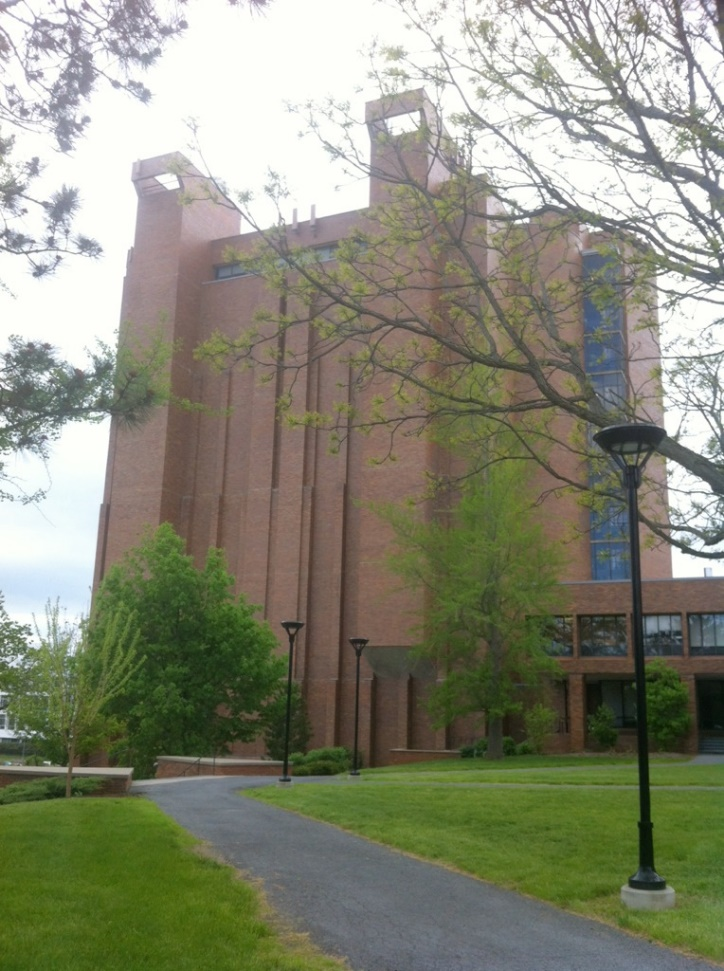
The Atmospheric Science branch of the Earth and Atmospheric Science department is located in Bradfield Hall at Cornell University, Ithaca.
The Community Earth System Model (CESM) we are using is the state-of-the-art. It encompasses 30 years’ worth of coding and scientific work from multiple teams across the world. The climate science community uses modelling to understand Earth processes better. Modelling is used to simulate past climates and project future climate change. Essentially, a model is a simplified Earth. However, as it is overly simplified, it is not perfect but it does a good job at reproducing most observations of the natural world. As such, models have now become the experimental laboratory of climate scientists.
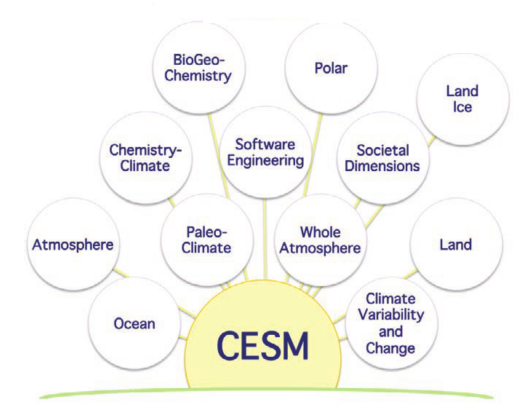
The CESM community (Hurrell et al., 2013.The community earth system model: A framework for collaborative research. Bulletin of the American Meteorological Society, 94(9), 1339-1360).
Now that the training week has finished, I can safely say that although I am not an expert by any means, I have gained an understanding of both terminal commands and climate modelling that has dissipated my fears. I look forward to designing my own experiments!
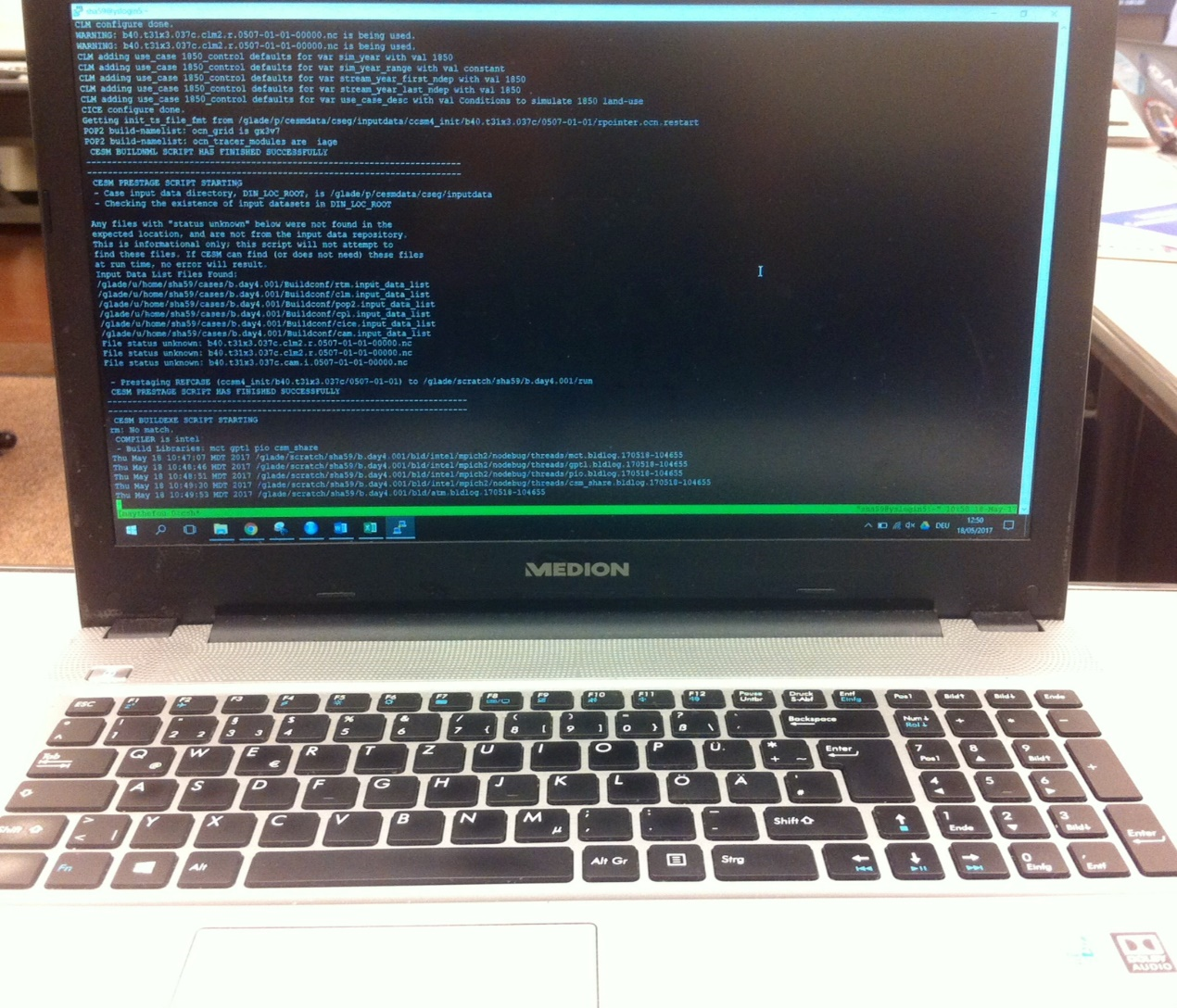
Running a climate model from a terminal connected to the Yellowstone supercomputer at NCAR, Boulder CO.
The societal costs of dust in the wind
Dust affects both the human and natural world. When we think of dust in Arizona, we picture haboobs sweeping through cities, walls of dust towering over buildings, engulfing and disrupting traffic.
Atmospheric dust has three main impacts on society.
- More dust in the atmosphere may be suppressing rainfall as it hinders droplet formation [1]. There is evidence that poor land management practices in the 1930s’ increased dust production through the reduction of vegetation cover and intensified drought associated with the dust bowl [2].
- More dust deposition on snow results in earlier snowmelt because it darkens the color of snow and darker colors absorb more heat [3]. Millions of people in the Four Corners region rely on water from snowmelt in the San Juan Mountains. Dust deposition on snow has the potential to affect water supplies and management.
- Dust causes respiratory illnesses by irritating the mucous membrane. Dust particles are small enough to penetrate deep into the lungs, causing allergic reactions, pneumonia, asthma, and silicosis [4]. Dust particles can also carry pathogens such as those responsible for Valley Fever and hantavirus [5].
However, it’s not all bad! Dust also fertilizes the oceans and soils but the negative impacts do overweigh the positive. Therefore, dust reduction should be a priority to alleviate impacts on society.
- Rosenfeld et al. (2001). Desert dust suppressing precipitation: a possible desertification feedback loop. PNAS, 98(11), 5975-80
- Cook et al. (2009). Amplification of the North American "Dust Bowl" drought through human-induced land degradation. PNAS, 106(13), 4997-5001
- Painter et al. (2007). Impact of disturbed desert soils on duration of mountain snow cover. Geophysical Research Letters, 34(12), 1-6.
- Griffin (2007). Atmospheric movement of microorganisms in clouds of desert dust and implications for human health. Clinical Microbiology Reviews, 20(3), 459-477.
- Middleton (2017). Desert dust hazards: A global review. Aeolian Research, 24, 53-63.
Tree sampling in the San Francisco Volcanic Field
by Stephanie Arcusa
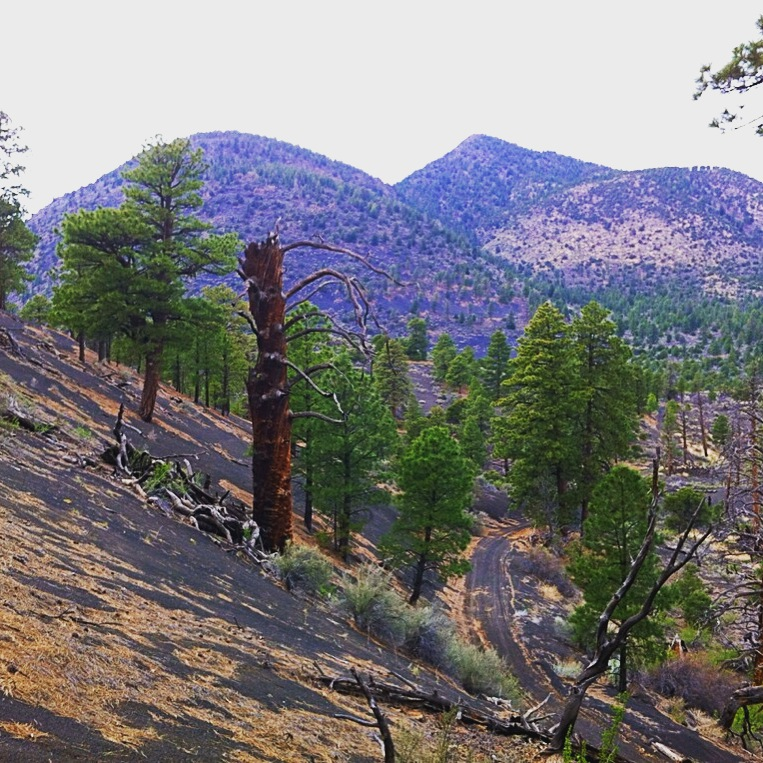
To me, ponderosa pines smell of butterscotch toffee. What does their smell remind you of? As I walked on cinder, the black volcanic dejects that make up the soils of the cones, I marveled at life’s ability to sprout from the harshest environments.
The San Francisco volcanic field is an area north of Flagstaff, AZ containing approximately 600 volcanoes. Not only has the field formed over (and is!) a geologic hotspot, it is also the gateway to the Four Corners dust source.
To understand the relationship between dust and drought back in time, I will need to find out about drought at the dust source. Trees are highly sensitive to moisture levels as seen from the widths of their rings. Drought causes narrow rings in trees.
However, we know very little about moisture levels in the Four Corners region over timescales longer than the past 300 years.
To fill this knowledge gap, Dr. Cody Routson and I drove around the cinder hills for hours one warm Tuesday afternoon in April 2017. We searched for the oldest ponderosa pine (Pinus ponderosa Douglas ex. C. Lawson). This mysterious old tree would have a naked peak, sagging low branches, and a twisted trunk. Ponderosas can live up to several hundred years. While collecting tree cores from these old trees will produce a long chronology, the key is remnant wood.
A felled tree may lie on the forest ground for decades to centuries, particularly when the dry climate of northeastern Arizona prevents decay. Our next field campaign will look for such trees, in the hope that our tree chronology can extend much longer than 300 years.
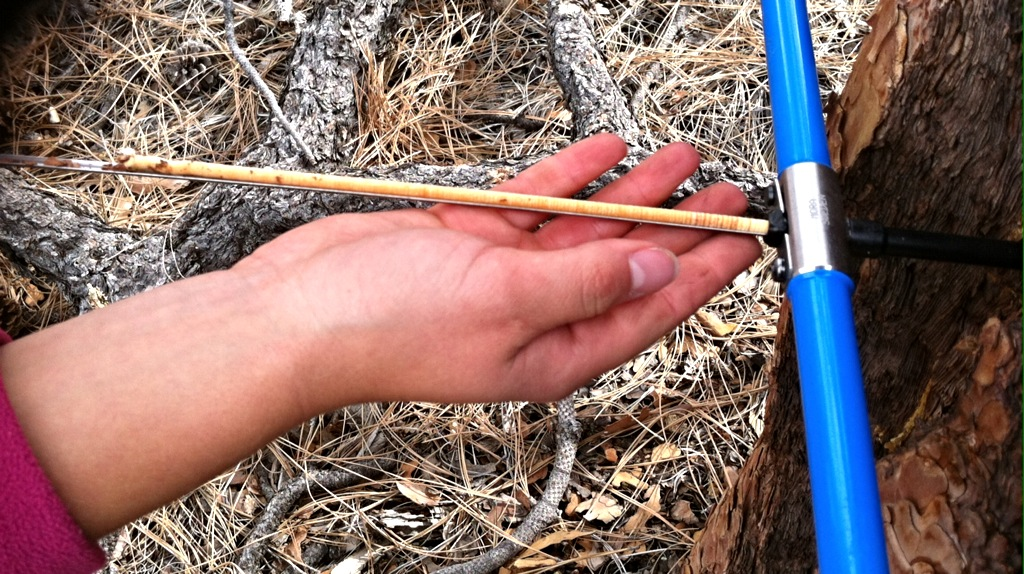
Coring a tree is like taking a blood sample from a patient. The sample tells us about the patient’s age and past injuries. It can tell us about the patient’s health history, the times of plenty and the tougher periods of their lives.
8 Things to Know About the Dust Busters
by Stephanie Arcusa
- The project brings together a team of multi-disciplinary scientists from Northern Arizona University, Flagstaff, AZ and Cornell University, Ithaca, NY in an attempt to foster collaboration and innovation. The team consists of paleolimnologists, dendrochronologists, climate modelers, and environmental and science policy scientists.
- The dust busting team is made up of Northern Arizona University principal investigator (PI) Dr. Nicholas McKay, co-PI Dr. Darrell Kaufman and Dr. Cody Routson, as well as PhD student Stephanie Arcusa (author of this blog). Cornell University scientists include collaborators Dr. Toby Ault and Dr. Natalie Mahowald.
- The Bob and Judi Braudy Foundation support the dust project. Dr. Robert and Judi Braudy are Cornell University graduates and now spend much of their retirement in Flagstaff.
- I moved to the U.S. specifically to work on the project, having previously lived in France, Ireland, the U.K., the U.S., Germany, and Switzerland.
- Dr. Cody Routson’s wife and infant child joined the fieldwork effort in October 2016. Sylvia, then 6 months old, was particularly happy to sit and collect rocks at 3000 m altitude.
- Dr. Cody Routson and I spent hours driving through ponderosa pine forest to find the oldest looking trees for their dendrochronology. The “oldest tree theory” suggests old ponderosa will have a denuded peak and heavy, sagging lower branches.
- I wish to make the results of the dust project relevant to local communities of the Four Corners region. This will involve presenting and discussing results to foster understanding of the dust history and issue.
- Master candidates Charles Mogan and Ethan Yackulic went on a reconnaissance survey of the study site. They visited several lakes in the San Juans, often hiking across mountain ridges to access lakes.

High altitude fieldwork in the Colorado Mountains
by Stephanie Arcusa
Collecting samples for paleoclimatology is rarely easy, in fact it is often downright challenging. We look for natural archives, such as lakes, glaciers or ocean sediment that have had little impact from human activities. In paleolimnology, the study of ancient lake sediment for climate research, this means visiting lakes in remote areas of the globe. For me, this was the high Andes of Ecuador, the northern reaches of Arctic Alaska, and the San Juan mountains of Colorado, to name but a few.
In October 2016, the dustbusters, a park ranger, and a cowboy and his mules made our way to Crater Lake in Weminuche Wilderness, Colorado. At 3500 m (11,640 ft) above sea level, it took us an entire day to reach our study site from the road, the mules progressing slowly up the narrow trails carrying the heavy and bulky equipment.
In paleolimnology we use lake sediment cores, long tubes of mud collected from the bottom of the lake, to say something about the climate of the past. In the dust-drought nexus project I am using lake mud to look at past dustiness over the Colorado Plateau for the past 12,000 years. That’s as long as people have lived in North America. We need to consider the past to have an idea of what the future may hold, a concept coined by geologist Charles Lyell back in the 1800s.
Using a makeshift mesh platform with a 2 metre metal tripod between two large banana boats, we set off to the middle of Crater Lake to hammer a heavy weight repeatedly to push a plastic pipe into the sticky lake mud. We then pulled and pulled this 4 m pipe full of mud through 20 m of water. That would be like carrying your overweight pet dog up five flights of stairs. Once the tube is back onto our inflatable boat, we paddle back to shore with the help of kayaks. We repeated the exercise three times to get several tubes. One of the cores hit a gas pocket in the sediment that destroyed the bottom part of the core. Apart from this small hiccup, we did not know our efforts were successful until we opened the tubes several days later back in the laboratory.
Such is the challenge of fieldwork. We only get one shot.
We cut the tubes into 1 m segments so the mules could transport them back. Each segment weighs approximately 10 kg.
Who you gonna call? Dustbusters! The diary of a climate science PhD
by Stephanie Arcusa
Nexus: a connection or link between things, persons, or events especially that is or is part of a chain of causation. – Merriam Webster Dictionary
Dust in paleoclimatology, the study of ancient climates, is not your average fluff found under the living room cupboard. Dust is windblown particles from exposed soil or broken up rocks. As drought reduces vegetation cover, it increases dust blowing away by wind because the roots no longer bind the soil grains together. The Dust Bowl of the 1930s was an example of a time of intense drought and dust concentration that affected the lives of millions. Can the Dust Bowl happen again in the future? How will drought and dust concentration change as humans are changing the climate? How has dust and drought changed in the past when climate was different to today? As part of my PhD project, I am elucidating this dust – drought nexus back in time and its impact on society. However, no one knows how this has changed over the Four Corners region of the Colorado Plateau. Therefore, this project must develop new methods to reach answers. Want to find out more? Stay tuned for updates from the dustbusters!

Stephanie Arcusa is a PhD student from France who started at NAU in 2016.